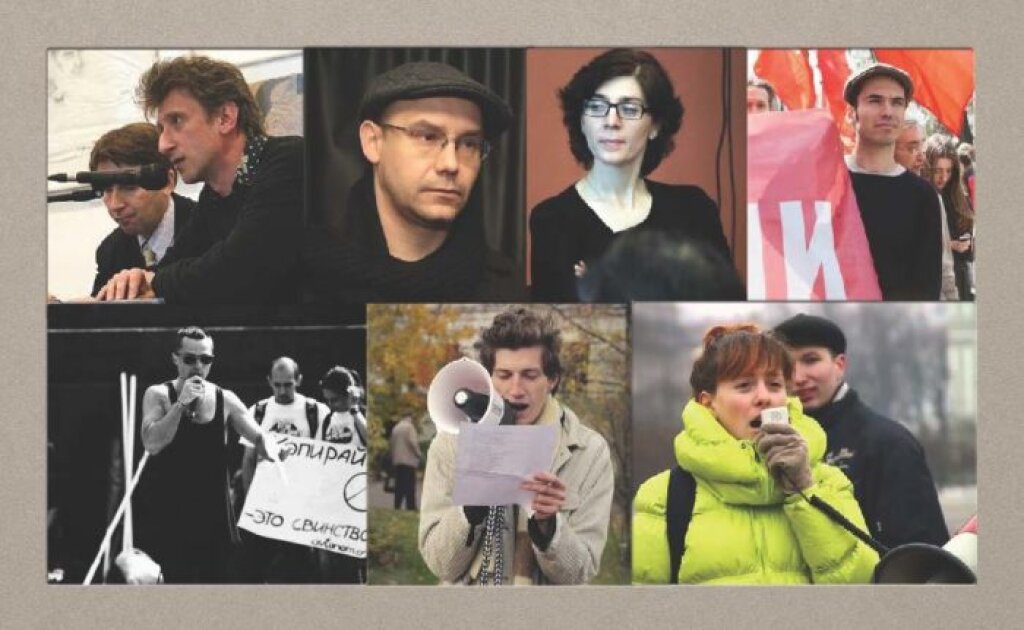On Friday, September 29th, the Jordan Center hosted a lecture entitled, “Putin’s politics and collective memories in Russia (2013-2015)”, featuring Julia Sweet, a Ph.D. Candidate at Rutgers University. The talk was introduced by Joshua Tucker, Director of the Jordan Center and moderated by Arturas Rozenas, Assistant Professor of Politics at NYU.
Sweet’s talk drew a link between the collective memories of Russia’s role in World War II (commonly referred to among Russians as the “Great Patriotic War”) and its current political relationship with Ukraine. Between 2008 and 2014, Putin’s ratings significantly declined. The Ukrainian Euromaidan of 2013-2014 sparked a surge of anti-Ukrainian propaganda on a range of Russian media outlets in an effort to weaken protest potential within Russian society, to strengthen patriotic sentiment and, perhaps most importantly, to increase Putin’s ratings. The propaganda campaign appeared prominently on three of the most popular Russian television outlets: NTV, Russia-1 and Pervyi Kanal, all of which are state-owned institutions. Moreover, today television remains the primary source of news for the majority of Russians and according to a 2014 survey conducted by the Levada Center, most Russians prefer to receive information from the three above-mentioned media outlets. Surveys also demonstrated that 59% of Russians have no doubts about the objectivity of news stories covering developments in Ukraine.
NTV, Russia -1 and Pervyi Kanal demonstrate several similarities, particularly their ties to the Russian government, their approaches to coverage of the events in Ukraine, and their propaganda strategies. Sweet noted that for all of these media outlets, professionalism took a back seat to the more important agenda of “institutionaliz[ing] a propaganda mechanism in Russia.” Moreover, the Kremlin’s focus in “shaping the political consciousness of Russians” manifested itself in the Russian media’s propaganda campaign. The structure of particular TV programs was also modified for the benefit of Putin’s political agenda. For example, in 2014, such programs as Sevodnya (“Today”), Vecher s Vladimirom Solovyovym (“Evening with Vladimir Solovyov”), and Politika (“Politics”) began to change their focus to the crisis in Ukraine. There also emerged new shows, including Vremya pokazhet (“Time Will Show”), Structure of Moment, and Spisok Norkina (“Norkin’s List”), that were initially intended to be sociopolitical but made state propaganda the highlight of their programs. These kinds of talk shows that aired between 2013 and 2015 demonstrated a calculated effort at employing the state’s agenda through a selective choosing of participants and monitoring of their positions on main issues. As Sweet noted, the frequency of TV appearances for talk show guests is contingent on their loyalty to the regime and overall, opponents of the state have been significantly underrepresented on such programs.
Sweet illustrated the fact that Russian state media outlets demonstrate similar propaganda methods, most notably name-calling, testimonials, repetition and transfer of focus. TV reporters have used such names as Ukro-fascists (Ukrainian fascists), neofascists, Banderovzi (followers of Stepan Bandera), neo-Nazis and Nazis in referring to opponents of the state. Through repetitive usage of such labels, reporters have strived to both depict the events in Ukraine in a particularly negative light and also to associate political figures in Ukraine with Russia’s enemies during World War II, thereby reinforcing Russian society’s patriotism and national identity. However, a shift in media rhetoric occurred in 2015 when reporters switched to using the labels nationalists and extremists.
Testimonials have also demonstrated an effective propaganda strategy in highlighting a sense of emotional resonance between reporters and viewers. Reporters have used testimonials from such public figures as Vladimir Zhirinovsky, Nikita Mikhalkov and Oleg Tsarev, as well as those from ordinary people, including war veterans, refugees and residents of the separatist regions. Presented within the format of talk shows, these narratives function to both establish the authority and reliability of public figures and to engage viewers through emotional quality without demanding an emphasis on facts and analysis. As an example, in April 2014 the Ministry of Foreign Affairs and the Ministry of Defense published archival documents about the activities of Stepan Bandera in Ukraine and Poland during the war. Russian TV stations widely broadcasted this news, which served to strengthen the credibility of Russia’s propaganda efforts in the fight against fascism.
Use of the documentary genre similarly employed an emotional power over Russian audiences and simultaneously transferred the focus of narratives, highlighting the strength of the Russian state in the face of Western opposition. For example, a series of propagandist documentaries about Ukraine was aired between December 2013 and March 2015. Technology of Maidan, the first of this series, aired on NTV in December 2013. The documentary depicted the way in which civil protests in Kiev transformed into violent riots and then juxtaposed this situation with the peaceful demonstrations in Moscow’s Bolotnaya Square in 2011-2012. By transferring the focus from images of violent uprising in Ukraine to peaceful protests in Russia, the media aimed to highlight simultaneously the “predatory” and corrupt nature of the West and the strength and efficiency of Putin’s regime.
Sweet concluded by reiterating the powerful connection that the Russian state maintains between collective memory of World War II and its propaganda campaign against Ukraine. State-owned media outlets demonstrate a calculated effort in engaging viewers and molding their patriotic sentiments, particularly through juxtaposition between images of an oppositional West and a strong and protective Russia.
Maya Vinokour, Faculty Fellow in the Department of Russian & Slavic Studies asked, What is the role of the Internet in Russians’ consumption of information? Sweet responded, noting that most Russians prefer to obtain their news from TV, rather than the Internet, because there is too much controversial information online and they are not willing to analyze it.


